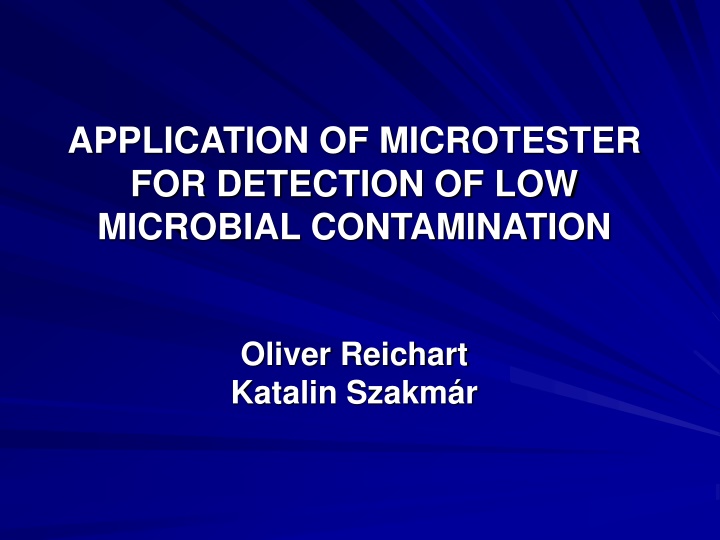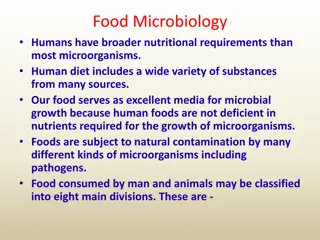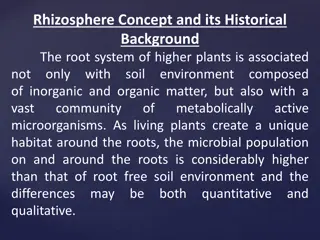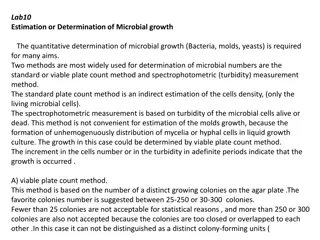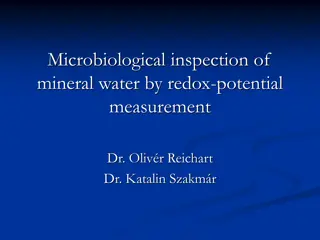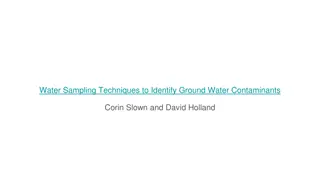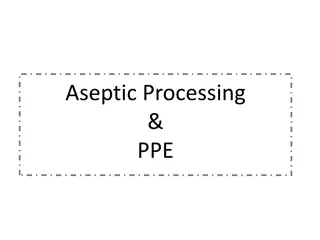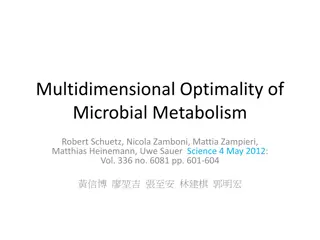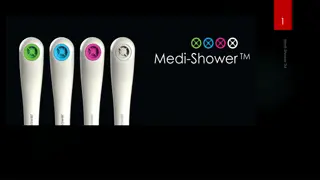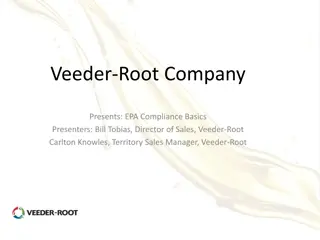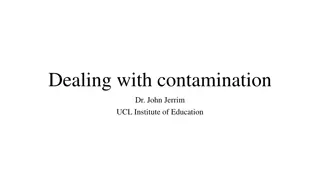Microtester for Low Microbial Contamination Detection
The Microtester method offers rapid, reliable detection of low microbial contamination by measuring redox-potential changes in the growth environment. This innovative approach reduces incubation time and provides concentration-dependent results. Utilizing a MicroTester System with water baths, test cells, and measuring modules, direct and indirect test cells can be employed to analyze redox-curves of bacteria, such as E. coli. Characteristics of the redox-curves, including detection criteria and detection time, offer insights into microbial multiplication for effective monitoring and control.
Download Presentation

Please find below an Image/Link to download the presentation.
The content on the website is provided AS IS for your information and personal use only. It may not be sold, licensed, or shared on other websites without obtaining consent from the author.If you encounter any issues during the download, it is possible that the publisher has removed the file from their server.
You are allowed to download the files provided on this website for personal or commercial use, subject to the condition that they are used lawfully. All files are the property of their respective owners.
The content on the website is provided AS IS for your information and personal use only. It may not be sold, licensed, or shared on other websites without obtaining consent from the author.
E N D
Presentation Transcript
APPLICATION OF MICROTESTER FOR DETECTION OF LOW MICROBIAL CONTAMINATION Oliver Reichart Katalin Szakm r
Classical microbiological methods Long incubation time (1-4 days) The applicability, reliability and test prices of the methods are concentration-dependent: High concentration: dilution and colony counting in the range of 30-300 cfu/ml. Low concentration: Membrane filtration
The Microtester method The energy source of the growth is the biological oxidation which results in a reduction in the environment. Due to the oxygen depletion and the production of reducing compounds the redox-potential of the nutrient medium changes. The redox-potential of the medium is a well measurable parameter which could be used for the determination of the microbial multiplication.
MicroTester System, 32 Channels Water baths Test cells Measuring modules Computer, Monitor
Redox-curves of several bacteria Redox curves in TSB (T=30 C) 400 200 Eh (mV) 0 -200 -400 0 2 4 6 8 10 12 14 16 18 t (h) steril Ps.aer. E.coli St. aur. Ent. faec. B.subt.
Characteristics of the redox-curves E. coli 37 C in TSB Eh logN 500 9 400 8 300 |dE/dt|>DC 200 7 Eh (mV) log Nc log N 100 6 0 -100 5 -200 4 TTD -300 log No -400 3 0 1 2 3 4 5 6 7 8 9 t (h)
Characteristics of the redox-curves Detection criterion (DC) The detection criterion is the critical rate of the change of redox-potential (dE/dt, the slope of the redox curve) which is significantly differing from the random fluctuation and could be ascribed to the multiplication of the microbes. (e.g. DC = |dE/dt| = 0.5 mV/min). Detection time (TTD) The detection time (TTD) is that moment when the absolute value of the rate of redox potential change in the measuring-cell exceeds the detection criterion. |dE/dt| DC mV/min). As the critical rate of the redox potential decrease needs a well-defined critical cell number (Nc = 107 cfu/ml) the detection time depends on the initial microbial count, N0.
Positive detection In the inoculated medium the microbes after the lag phase start to multiply. Due to their metabolism the redox-potential decreases in the test cell. After a time (depending on the inoculum size) the rate of decrease exceeds the detection criterion. The system gives a TTD value which refers to the presence of multiplying microorganisms (in about 106-107cfu/ml concentration). Keeping on the redox-measurement appears a typical redox-curve characterizing on the microbe or microbial group growing in the test cell. As a result of the multiplication we get a suspension of 107-108cfu/ml with visual turbidity.
False positive detection in selective medium In case of massive inoculation (i.e. from the surface of solid medium with a loop) the initial microbe concentration in the test cell could exceed the value of 107-108cfu/ml and causes visual turbidity. The exo-enzymes and metabolites of the inoculum start immediately to reduce the redox-potential of the medium which could result in TTD detection in the initial concave section of the redox-curve. As the multiplication is inhibited by the selective medium the characterising convex section of the redox-curve does not evolve.
Redox curves in cetrimide broth Growth in cetrimide broth 500 400 Eh (mV) 300 200 100 0 0 5 10 15 20 time (h) Ps4 Ps5 Ps6 Ps. fluorescens E. coli Enterococcus
Effect of the inoculum size on the redox-curves E. coli, TSB, 37 C 400 200 Eh (mV) 0 -200 -400 0 2 4 6 8 10 12 14 t (h) Sterile lgN=0,09 lgN=2,38 lgN=3,39 lgN=4,25 lgN=4,80 TTD for the redox-potential measurement is: | E/ t|>1mV/min
Effect of the initial cell concentration on TTD y = -1,1996x + 8,3112 R2 = 0,9795 E.coli, TSB, 37 C 10 8 TTD (h) 6 4 2 0 0 1 2 3 4 5 logN (cfu/inoculum)
Calibration curves Strict linear relationship exists between the logarithm of the viable count of the test cell inoculum, log N(c) and the detection time (TTD) which is represented by the calibration curve. The equation of the calibration curve makes possible to calculate the viable cell count on the base of TTD in a very wide range: log N(c) = A TTD + B The calibration curves refer on the test cell and the microbial contamination of the sample is calculated by the software automatically.
MPN calibration curves MPN calibration curve is applied when the previously constructed calibration curve cannot be taken. In this case, the redox potential measurement could be combined with the MPN method and the software makes possible the on-line determination the most probable microbial count and the calibration curve. From the sample the usual dilution series is prepared up to a dilution which is free of microbe. In case of low cell numbers apply membrane filtering. Place the membranes into the measuring cells and record the redox curves.
Determination of the calibration curve Based on the last dilution level still showing multiplication (TTD), the most probable cell-number of the undiluted (most concentrated) sample, MPN(0) is determined automatically by the program. With the knowledge of MPN(0) and TTD values belonging to the several dilutions, the software calculates the equation of the log MPN calibration. Having determined the microbial contamination of the sample with a classical reference method and inputting the result, the system automatically recalculates the MPN calibration to logN calibration.
Calibration curve E. coli, membrane filtering, V = 100 ml 10 8 logN(c) = - 0.933 TTD + 9.099 log N(c) 6 4 2 0 0 2 4 6 8 10 TTD (h)
Redox-curves. How long to measure? If we have got TTD value it is proposed to continue the measurement until the redox curve is taking shape. Having no TTD it is proposed to measure until the estimated microbial count in the test cell (calculated by the calibration curve) drops below 1/100, logN(c) < -2.
Time to detection no microbe, TTDN In the test cell logN(c) -2 logN(c) = A TTD + B TTD = [logN(c) B] / A A = -0.933 h-1 B = 9.099 TTDN 11.2 h Time to detection no microbe:
Time to detection no microbe, TTDN Microbe/medium Medium Calibration A (h-1) TTDN (h) 16,4 14,4 22,5 18,5 19,2 25,6 23,7 23,9 (ml) B E. coli 15 -0,627 8,307 BBL 44 C Cb. freundii 50 -0,854 10,260 15 -0,420 7,449 BBL 37 C Ps. aeruginosa 50 -0,667 10,332 15 -0,595 9,456 Cetrimide 37 C Entc. faecalis 50 -0,513 11,111 15 -0,406 7,645 Azide 37 C 50 -0,480 9,482
Application for low microbial contamination Membrane filtering Microbe concentration of the sample: N(0) cfu/ml Volume of the filtered sample: Detection limit in the test cell: Detection limit of the sample: V(0) ml N(c)min = 1 cfu/test cell N(0)min = N(c)min/V(0) N(0)min = 1/V(0) cfu/ml Do not forget: In the low microbial concentration range the probability of the detection is highly affected by the test volume.
Linearity of membrane filtering E. coli, BBL 37 C y = -1,12x + 9,1972 R2 = 0,9871 10 8 TTD (h) 6 4 2 0 -1 0 1 2 3 4 5 6 membrane 1 ml logN(c) (cfu/cell)
Detection of microbial contamination Sampling and testing the product To find the defective unit and detect the contamination Distribution of micro-organisms in the product Contagious distribution ( 2> ) Sporadic occurrence of defective units Main problem is to find the defective units Random distribution ( 2= ) Main problem is to detect the low microbial count Basic assumption: Even one viable cell results in positive test.
Effect of the test volume on the detection Legends Ns: average microbe-concentration of the sample (cfu/ml) Vs: sample-volume (ml) n : sample size Vi: The total volume tested Ni : Inoculated total cell number in the all tests (cfu) Ni = Ns Vi Vi= Vs n
Probability of positive test Zero tolerance, positive test is not allowed The probability of n negative test: N = = = ( ) 0 P P N e i negt The probability of minimum 1 positive test: N = = = ( ) 0 1 1 P P N P e i post negt
Comparison of the classical and redox methods At a given microbial concentration the effectiveness of the testing depends on the filtered volume: Vi = Vs n Example for mineral water testing: Vs = 250 ml/sample Classical membrane filtration, 1 membrane for 3 samples 1 Petri dish for 1 membrane = 3 samples Microtester method with normal loading 1 membrane for 4 samples 1 test cell for 5 membranes = 20 samples
Probability of positive test Membrane filtration Vi (ml) = 75000 Vi (ml) = 40000 Vi (ml) = 18000 1,0 N = 0.01cfu/L cfu/L 0,8 N = 1cfu/L 0,6 Ppos 0,4 0,2 0,0 -6 -5 -4 -3 -2 logN/ml sample
Probability of positive test n = 300 n = 160 n = 72 Membrane filtration 1,0 0,8 0,6 Ppos Vs = 250 ml 0,4 0,2 0,0 0,0 0,1 0,2 0,3 0,4 cfu/1000ml sample
Presence/Absence tests 1. 72 bottles tested for Coliform (09 Aug 2005) Method of Laboratory, Tergitol agar, 24 Petri dishes Membrane filtering 3 x 250 ml with 1 filter. Placing 1 filter in a Petri dish One Petri dish represents 3 bottles Detection threshold: 1 microbe/750ml Redox potential method, BBL broth, 6 Channels, Membrane filtering 3 x 250 ml with 1 filter. Placing 4 filters in a test cell. One test cell represents 12 bottles Detection threshold: 1 microbe/3000ml All negative All negative Positive control: 1 ml Citrobacter freundii suspension (logN = 3.66)
Advantages of the redox method in the evaluation of membrane filtration The time requirement of the redox-potential technique is significantly lower than that of the classical nutrient methods. While the classical methods use only 1 membrane in 1 Petri dish the redox-potential method makes possible to evaluate even 5 or more filters in one test cell. That means not only a 5 times lower detection limit of microbes but results in a remarkable cost reduction as well.
